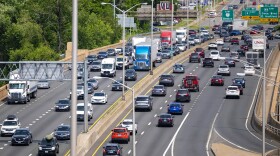The air turned orange—and the whole city felt it.
As smoke from Canadian wildfires blanketed New Haven in 2023, it sent fine particle pollution soaring to more than 15 times the normal daily level. The sky turned hazy, health officials urged residents to stay inside, and what once seemed like gradual progress toward cleaner air suddenly felt alarmingly fragile.
New Haven’s air quality has improved overall in recent years. But the gains aren’t equally shared—and they’re easily reversed by climate events and policy setbacks. Residents in lower-income areas, often near highways and industrial sites, still breathe some of the dirtiest air in the state.
Dr. Mark Mitchell, a public health physician and founder of the �������� Coalition for Environmental Justice, said these disparities are rooted in planning decisions made decades ago.
“Highways were often built right through Black and Latino neighborhoods,” Dr. Mitchell explained. “People of color are more likely to live near polluting sources like power plants, highways, and airports—and they suffer the health consequences.”
He pointed to elevated rates of asthma, cancer, and even neurodevelopmental issues like ADHD and autism—issues that emerging science links to long-term pollution exposure.
Government data backs up these concerns. According to the U.S. Environmental Protection Agency’s Air Quality System, average annual levels of PM2.5 (which stands for fine particulate matter smaller than 2.5 micrometers) in New Haven dropped from 8.6 micrograms per cubic meter in 2015 to 6.2 in 2024—nearing proposed federal health targets.
These particles include tiny bits of pollution from engines, heating systems, wildfires and industrial activity.
But 2023 was a cautionary tale: wildfire smoke pushed the annual average back up to 8.7, a level not seen since the previous decade. Fortunately, by 2024, levels dropped again, thanks in part to shifting weather patterns and fewer fire-related events.
Still, long-term averages hide dangerous seasonal peaks. PM2.5 levels climb in both summer and winter due to vehicle emissions, wildfires, heating fuel, and imported pollution. Ozone levels, which worsen in summer sun, spike most dramatically in July.
For people with preexisting health conditions, these aren’t just numbers.
Khaoula Boulhadi, a 22-year-old neuroscience student at Southern �������� State University and New Haven resident, has lived with asthma since childhood.
“My asthma gets way worse in the summer,” she said. “If the air quality is bad, I stay inside or carry my inhaler everywhere.”
As a neuroscience student, she worries that pollution’s effects go further than most people realize.
“It’s not just asthma,” she said. “Pollution is tied to learning problems, mental health, and even brain development.”
To older residents like Stella Owens, 79, the pollution isn’t new. Owens still lives on Ella T. Grasso Boulevard, where she grew up.
“You’d wipe your windows, and it was black,” she said. “That’s what we were breathing.”
She acknowledged that some things have improved, but added: “Just because you can’t see the pollution every day doesn’t mean it’s not there.”
Owens remembers the days before catalytic converters and clean air regulations. But the same neighborhoods that once sat beside dirty bus depots and oil furnaces now face new forms of risk—like highway truck emissions or wildfire smoke.
Another thing that’s changed is how clearly those risks can now be measured.
In 2022, New Haven launched a citywide sensor network to track air quality in real time. The sensors confirmed what many residents had long believed: major differences in air pollution exist between neighborhoods.
Fresh data from the summer of 2024 backs this up, showing that some areas still face far worse air than others. Between June and August, publicly available air quality sensors operated by the city showed that average levels of PM2.5 were consistently higher in areas near industrial sites and busy roads.
In the Annex, which borders the port and airport, the average PM2.5 level was about 9.5 micrograms per cubic meter of air. That’s just below the federal Environmental Protection Agency’s new annual safety limit of 9. In Fair Haven, a neighborhood near I-91, the average was around 8.0. By comparison, East Rock measured 7.0, and Westville—farther from traffic and industry—had the cleanest readings at about 6.5.
These findings come from the city’s Engineering Department, which publishes real-time data from 11 low-cost sensors located across New Haven. The sensors are part of a public dashboard available on the city’s website and through the PurpleAir sensor network.
“People deserve to know what they’re breathing,” Mayor Justin Elicker said at the program’s launch.
The new data is already helping residents advocate for environmental justice and make informed decisions about their health.
Despite progress, New Haven still records multiple bad air days each summer and remains vulnerable to outside threats like wildfire smoke. For environmental justice communities— like the Hill, Fair Haven, and Dixwell—the stakes are especially high. These neighborhoods have higher asthma rates and are often closer to highways, rail yards, and polluting facilities.
If nothing changes, those who contribute least to pollution—like residents without cars— will continue to suffer the most.
“It’s an injustice that people who don’t even drive are breathing in pollution from the highway they live next to,” Dr. Mitchell said.
The solution won’t come from one action alone. Advocates say that expanding the city’s air sensor program, improving public transportation, electrifying buses and trucks, and enforcing clean air regulations are all needed to make sure the city’s progress continues — and that no neighborhood is left behind.
Youssef Rafik is a student at Southern �������� State University. This story is republished via , a service of the �������� Student Journalism Collaborative, an organization sponsored by journalism departments at college and university campuses across the state.




